Fisheries production in Northern Mindanao decelerates by 11.0 percent
Fisheries production in Northern Mindanao for the second quarter of 2020 slowed down by 11.0 percent, recording 38,468.4 metric tons in the current period from the recorded production of 43,212.8 metric tons in the same period of the previous year. This was attributed to the decrease of production in all its subsectors. (Table 1)
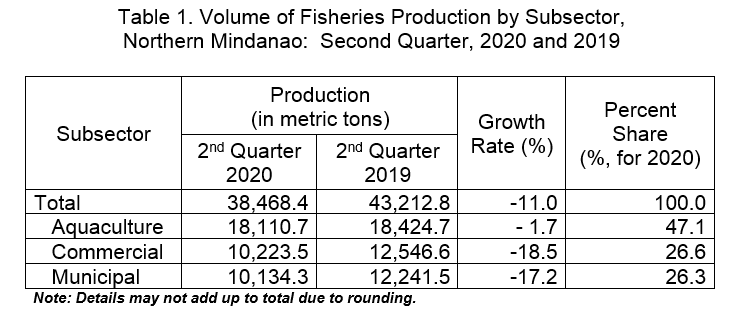
Marine fisheries, which contributed 91.2 percent of the total municipal fisheries production, posted a 15.6 percent decrease in production. It registered a production of 9,240.6 metric tons in the current period from 10,947.1 metric tons in the same quarter of the previous year. (Table 2)
Moreover, inland municipal fisheries, which accounted for 8.8 percent share of the total municipal fisheries production, also posted a 31.0 percent decrease.
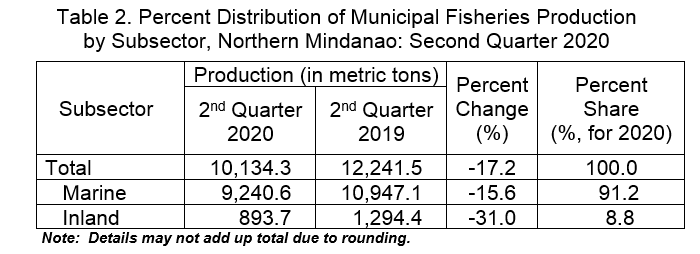
Lanao del Norte dominates fisheries production
Among provinces, Lanao del Norte contributed the biggest chunk of fisheries production at 18,557.6 metric tons, comprising 48.2 percent of the total fisheries production in the region. Misamis Occidental (36.5%) ranked second at 14,048.9 metric tons, followed by Misamis Oriental (4,731.1 MT or 12.3%), Camiguin (646.4 MT or 1.7%), and Bukidnon (484.5 MT or 1.3%). (Figure 1)
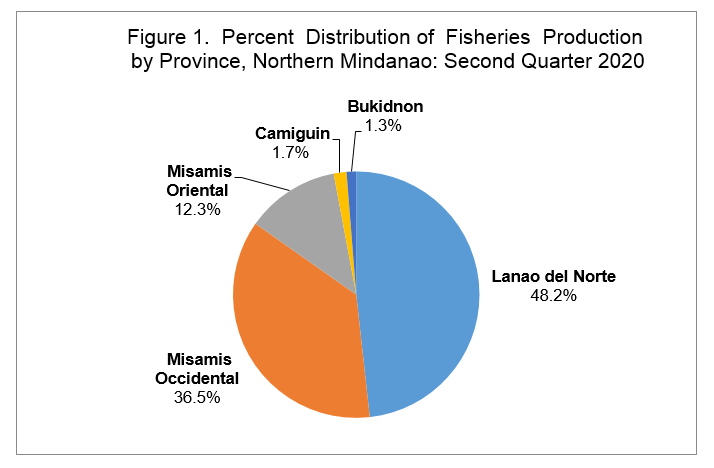
Misamis Occidental leads in the commercial and municipal fisheries production
Misamis Occidental (4,241.0 MT) dominated the production of commercial fisheries which accounted for 41.5 percent of the total. Lanao del Norte (3,190.1 MT or 31.2%) ranked second, followed by Misamis Oriental (2,741.9 MT or 26.8%) and Camiguin (50.5 MT or 0.5%). (Figure 2)
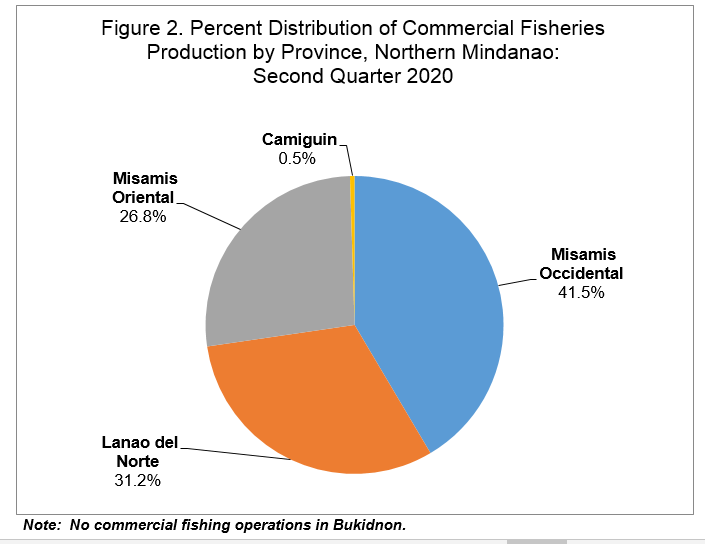
Likewise, Misamis Occidental (48.0%) contributed the biggest share in municipal fisheries production at 4,869.3 metric tons. Lanao del Norte (2,709.3 MT or 26.7%) ranked second, followed by Misamis Oriental (1,519.3 or 15.0%), Camiguin (591.1 MT or 5.8%), and Bukidnon (445.2 MT or 4.4%). (Table 3)
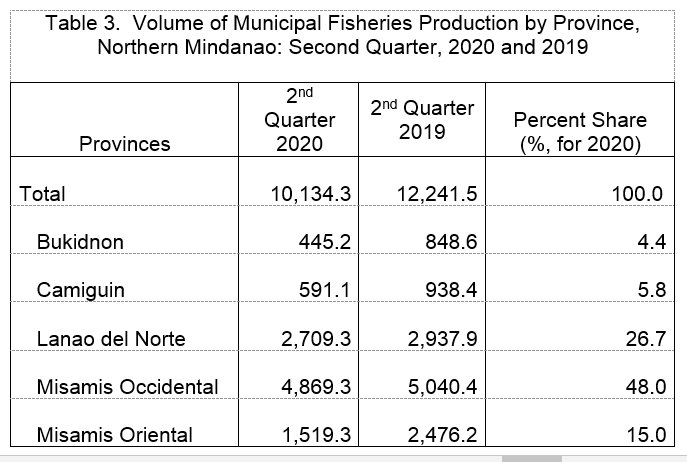
Lanao del Norte tops aquaculture fisheries production
Lanao del Norte (12,658.2 MT) contributed the biggest share of aquaculture fisheries production which accounted for 69.9 percent of the total. Misamis Occidental (4,938.6 metric tons or 27.3%) ranked second, followed by Misamis Oriental (469.9 MT or 2.6%), Bukidnon (39.3 MT or 0.2%) and Camiguin (4.7 metric tons or 0.03%). (Figure 3)
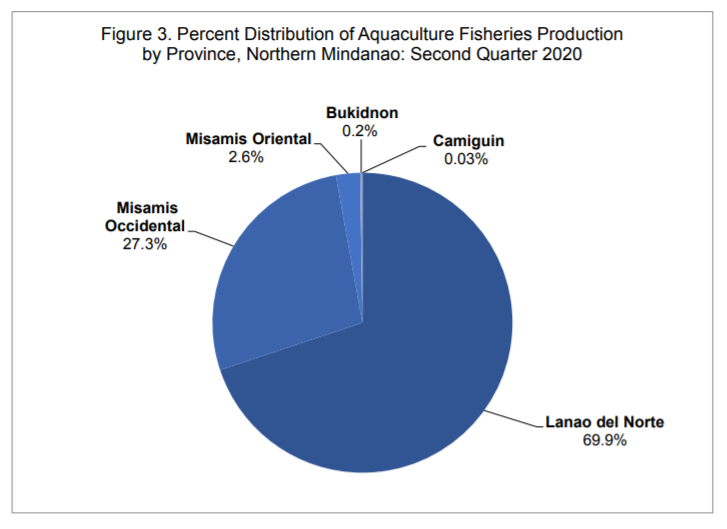
VIRGIE A. GAYLA
(Chief Administrative Officer)
Officer-in-Charge
For further inquiries, you may contact:
Statistical Operations & Coordination Division
Philippine Statistics Authority Regional Statistical Service Office 10
2nd Floor, Bldg. 4, Pride Rock Business Park
Gusa Highway, Cagayan de Oro City
Email: psaregion10@gmail.com
Telefax: (088) 856-4778
TECHNICAL NOTES
This Special Release presents the preliminary results on the volume of production of fisheries in Northern Mindanao for the second quarter of 2020. It contains information on the fisheries subsector, namely: commercial fisheries, municipal fisheries, and aquaculture. Data use were from the four (4) fisheries surveys regularly conducted by the Philippine Statistics Authority (PSA): Quarterly Commercial Fisheries Survey (QCFS), Quarterly Municipal Fisheries Survey (QMFS), Quarterly Inland Fisheries Survey (QIFS) and Quarterly Aquaculture Survey (QAqS).
Concepts and Definitions
Volume of Production - the quantity of fish unloaded in the landing center, caught in inland bodies of water and/or harvested/produced from aquafarms; presented in metric tons.
Fisheries - all activities relating to the act or business of fishing, culturing, preserving, processing, marketing, developing, conserving and managing aquatic resources and the fishery areas including the privilege to fish or take aquatic resources thereof (RA 8550).
Commercial fishing – the catching of fish with the use of fishing boats with a capacity of more than three gross tons for trade, business or profit beyond subsistence or sports fishing.
Marine Municipal Fishing - covers fishing operation carried out with or without the use of a boat weighing three gross tons or less.
Inland Municipal Fishing - the catching of fish, crustaceans, mollusks and all other aquatic animals and plants in inland water (e.g. lakes, rivers, dams, marshes, etc.) using simple gears and fishing boats some of which are non-motorized with a capacity of three gross tons or less; or fishing not requiring the use of fishing boats.
Aquaculture - fishery operation involving all forms of raising and culturing of fish and other fishery species in marine, in fresh, brackish and marine water areas. The operation is comprised of activities from stocking to harvesting of species under controlled conditions in farming facility called aqua farm.

